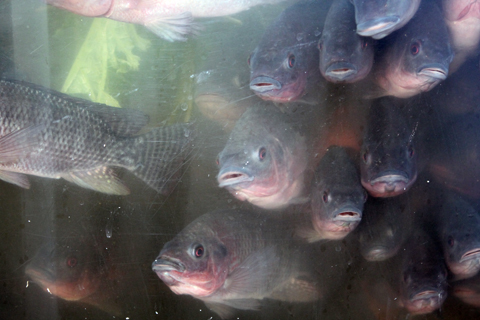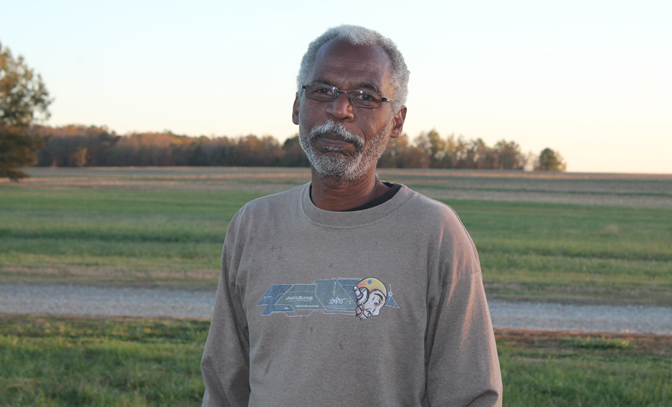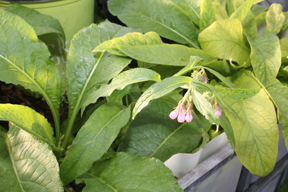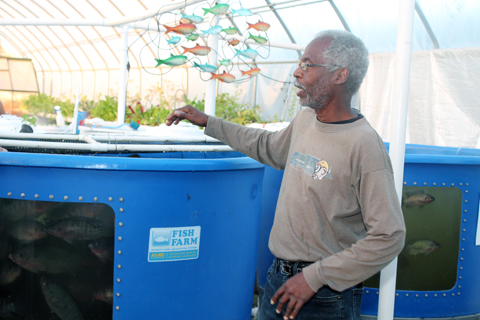AAMU Tilapia Operation Offers Opportunities

The Circle of Sustainability
After a three-year investment from a USDA-sponsored grant, agricultural research scientists at Alabama A&M University are swimming ever closer toward full implementation of a ‘circle of sustainability.’
 Associate Research Professor Ernst Cebert, who also manages the University’s Winfred
Thomas Agricultural Research Station (WTARS) in Hazel Green, Ala., has received some
$300,000 over the years from the Evans-Allen program earmarked for 1890 land-grant
institutions to develop a self-sustaining aquaculture/hdroponic system that not only
potentially provides hands-on learning experiences for a plethora of disciplines,
but one that also offers quality, healthy tilapia for the market.
Associate Research Professor Ernst Cebert, who also manages the University’s Winfred
Thomas Agricultural Research Station (WTARS) in Hazel Green, Ala., has received some
$300,000 over the years from the Evans-Allen program earmarked for 1890 land-grant
institutions to develop a self-sustaining aquaculture/hdroponic system that not only
potentially provides hands-on learning experiences for a plethora of disciplines,
but one that also offers quality, healthy tilapia for the market.
“We wanted to show that we can create everything related to raising a self-contained product, free from pesticide and cutting down on the often costly use of fish food,” explained Cebert.
 The project actually started in a greenhouse on the campus proper, but it was moved
to the research farm. This allowed for ample space and the use of well water. A
group also was hired to assist with system design and setting up additional technology
to convert fish waste into functional fertilizer. Cebert said tilapia was selected
primarily because the species is fairly easy to raise and isn’t particularly picky
about what it consumes.
The project actually started in a greenhouse on the campus proper, but it was moved
to the research farm. This allowed for ample space and the use of well water. A
group also was hired to assist with system design and setting up additional technology
to convert fish waste into functional fertilizer. Cebert said tilapia was selected
primarily because the species is fairly easy to raise and isn’t particularly picky
about what it consumes.
A lot of tilapia eaten in America is produced in other countries, primarily China. As more people inquire about their food sources and the conditions under which that food source is produced, Cebert said locally produced fish can alleviate a lot of concern.
The circle of sustainability doesn’t necessarily have a beginning nor an end point.
A system is created that is favorable for fish to thrive and reproduce, calling for
constantly  oxygenated water and other imperatives. Plants are raised to feed the fish to one
and a half to two-pound maturity. The fish consume leaves from the plant and then
produce waste. The solid and liquid waste from the fish is then pumped out and becomes
part of an elaborate compost/fertilizer system. The resulting rich soil of the compost
provides required nutrients for the plants being grown to feed the fish, as well as
water for those plants growing hydroponically along the interior periphery of the
greenhouse.
oxygenated water and other imperatives. Plants are raised to feed the fish to one
and a half to two-pound maturity. The fish consume leaves from the plant and then
produce waste. The solid and liquid waste from the fish is then pumped out and becomes
part of an elaborate compost/fertilizer system. The resulting rich soil of the compost
provides required nutrients for the plants being grown to feed the fish, as well as
water for those plants growing hydroponically along the interior periphery of the
greenhouse.
Cebert said the process ultimately results in a cleaner, healthier product; a lower percentage of premature fish deaths, and no contaminants from the surrounding controlled environment.
Other positives involve what ongoing operations could mean for instruction and research, noted Cebert. For instance, there are numerous potential training opportunities through the self-sustaining tilapia farm. Environmental science students could play a role in testing the plants and soil for quality. Engineering students could help design systems that could automate the waste pump and filtration process. Moreover, food science students could run comparisons between the tilapia from the AAMU farm and the tilapia currently found in the market.
The tilapia operation could provide a multifaceted learning environment for visiting school children at all levels. But, when all is said and done, Cebert would like nothing more than for his pounds and pounds of tilapia to someday find their way on the plates of a specialty restaurant.
by Jerome Saintjones